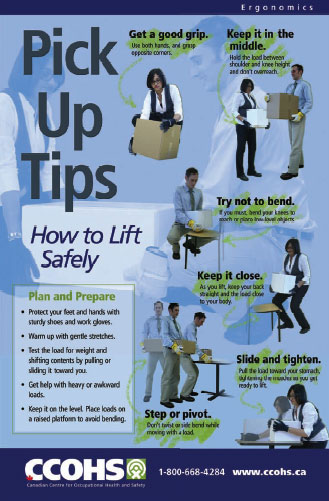Physical Hazards
Physical hazards include equipment or circumstances that can cause injury or illness, including noise, improper lighting, sharp edges and heavy lifting.
Common physical hazards and associated Health, Safety and Environment (HSE)
services and resources are listed below:
There are a number of restricted and confined spaces throughout the university, including boilers, wet wells, tanks, vessels, sewer manholes, electrical vaults, crawlspaces, air handling units (AHU), mechanical spaces, pits and excavations. Work in these spaces can involve serious health and safety risks, including asphyxiation, drowning and movement-related injuries.
HSE provides the following resources related to working in confined or restricted spaces:
- Confined space code of practice open in a new tab: Outlines requirements for protecting workers.
- Restricted and confined space infographic open in a new tab: Images and examples of confined and restricted spaces.
Hazardous energy is any electrical, mechanical, hydraulic, pneumatic, chemical, nuclear, thermal, gravitational or other energy that can harm personnel and cause injury.
HSE provides the following resources related to working on equipment or systems containing hazardous energy sources:
- Energy isolation code of practice open in a new tab: Requirements to prevent unintended release of energy as well as the unintended start-up, motion, or contact with equipment or system containing or producing hazardous energy.
Working at heights includes any activities whereby a worker may fall from a distance. Examples include work conducted on a ladder, research conducted on a rooftop, or work involving scaffolding or scissor lifts.
HSE provides the following resources related to working at heights:
- Work at heights program open in a new tab : Outlines requirements for all work occurring at height.
- Fall protection program open in a new tab : Outlines procedures, equipment, and installation requirements.
- Roof access program open in a new tab : Requirements for accessing rooftops at the U of A.
- Ladder safety guidelines open in a new tab
- Mobile aerial work platforms (MEWP) guidelines open in a new tab : Requirements for using MEWP equipment, such as lifts and bucket trucks.
- Scaffolding guidelines open in a new tab : Requirements for working on mobile and permanent scaffolds.
Strenuous and repetitive motions (such as heavy lifting or conducting the same task repetitively) can contribute to traumatic injuries and work-related musculoskeletal disorders such as carpal tunnel syndrome and tendonitis.
The Canadian Centre for Occupational Health and Safety provides fact sheets and other resources open in a new tab to help prevent injuries associated with improper lifting, pushing and pulling.
HSE also offers a self-assessment tool and online training to help you to evaluate your workstation and make ergonomic adjustments as required.
Noise poses a hazard in the workplace when employees are exposed to a time-weighted average of 85 decibels (dBA) over eight hours.
HSE conducts noise assessments (as required and upon request), does audiometric testing of noise-exposed workers, and provides advice related to noise exposure as well as to nuisance noise open in a new tab (<85 dBA but which may be stressful and produce irritability or distractions).
"Sharps" refers to devices or objects that can puncture or lacerate the skin. Examples include:
- Dental burrs
- Dissection pins
- Hypodermic needles
- Microtome and cryostat blades
- Scalpels and razor blades
- Scissors
- Used graduated pipette and pipette tips
Every year sharps contribute to a significant number of cut and puncture injuries at the U of A.
Research groups should regularly review how sharps are used in the laboratory to determine if equipment and procedures can be improved to reduce the likelihood of injury.
Slips and trips are the leading cause of workplace injuries at the U of A. Each year, dozens of staff and students trip on steps, cables, uneven surfaces, ice or other slick surfaces.
Basic housekeeping measures, to ensure that cables are gathered and stored safely, or to ensure that aisles and hallways are clear of obstacles, can go a long way to reducing the risk of tripping. Likewise, making decisions to avoid slippery surfaces and wear appropriate footwear can help to prevent injuries related to slipping.
Exposure to ultraviolet (UV) radiation from the sun can lead to harmful skin changes including sunburn, premature aging, eye damage and skin cancer. Individuals working outdoors should practice sun safety on a daily basis. To reduce UV exposure:
- Check your local weather to determine the UV index for the day.
- Discuss UV risks with coworkers and take the UV protection course open in a new tab online.
- Implement controls that are appropriate to the UV Index open in a new tab
Thermal stress, defined as working in extremely hot or cold environments, can pose health risks. The OHS Code requires that employers identify and assess thermal hazards and implement control measures to protect workers from associated injury and illness.
HSE provides the following resources related to heat and cold stress in the workplace:
- Thermal Stress Program open in a new tab : Outlines requirements for protecting workers.
- Heat Stress Program open in a new tab : Best practices for working in hot environments.
- Assessing heat stress open in a new tab : Outlines steps to evaluate risk of heat stress.
- Cold Stress Program open in a new tab : Best practices for working in cold environments.
- Assessing cold stress open in a new tab : Outlines steps to evaluate risk of cold stress.
Ensure that you have conducted a hazard assessment and identified all physical hazards and implemented control measures before you start work.

